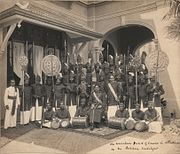Lascarin
| Lascarins | |
|---|---|
|
The Lascoreen Guard of Padikara Muhandiram Arthur Silva Wijeyasinghe Siriwardena
|
|
| Active | 1500s–1930s |
| Country |
|
| Allegiance |
|
| Branch | Army |
| Type | Infantry |
| Engagements |
Sinhalese–Portuguese War Dutch–Portuguese War |
Lascarins (or Lascareen or Lascoreen or Lascarine) (Sinhalese: ලස්කිරිඤ්ඤ laskirigngna) is a term used in Sri Lanka to identify indigenous soldiers who fought for the Portuguese during the Portuguese era (1505–1658) and continued to serve as colonial soldiers until the 1930s. The lascarins played a crucial role not only in the colonial armies, but also in the success of the campaigns of the local kingdoms.
The term originates from the Persian word Lascar, pronounced Lashkar (Persian: لشکر), meaning military camp or army - related to the Arabic 'Askar (Arabic: عسكر), meaning 'guard' or 'soldier' (whence Askari). The Portuguese adapted this term to lasquarin or lascarim, meaning an Asian militiaman or seaman. The latter meaning is preserved in English as Lascar. In Sri Lanka it was used in the military sense, which was also preserved in India as Gun Lascar. The Dutch adapted it to lascorijn and the English to lascariin, lascarine, lascoreen, etc.
The Portuguese first landed in Sri Lanka in 1505 and by 1517 they were able to erect a fort in Colombo and controlled most of the inbound and outbound trade affairs. After the historical event known as 'Wijayaba Kollaya' in 1521 they became involved in the internal affairs and conflicts between local kingdoms. Due to the limited manpower from Portugal, the Portuguese hired local soldiers to defend Portuguese and the Kotte kingdom's interests and to assist in offensive purposes. Almost all of these Lascarins were Catholic converted Sinhalese (and in some cases Tamils) such as the Karava and the Niar. This was a time when many members of local royalty was adopting Catholicism. After the Portuguese imposed direct control on local kingdoms (mainly the Kingdom of Kotte), many of the forces loyal to the king of Kotte became Lascarins and continued to hold ranks such as Mudali, Muhandiram, Arachchi or Kankani.
...
Wikipedia

